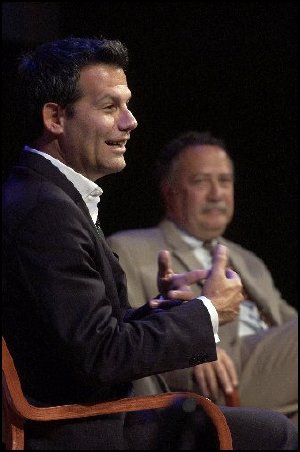Center Cities, Joel Kotkin, Alice Rivlin, and the future of DC
 Richard Florida, left, author of The Rise of the Creative Class, and Joel Kotkin, at a conference in Denver. Photo from the Denver Rocky Mountain News.
Richard Florida, left, author of The Rise of the Creative Class, and Joel Kotkin, at a conference in Denver. Photo from the Denver Rocky Mountain News.Joel Kotkin recently came out with a new book, The City: A Cultural History and he is supporting it through a barrage of op-ed pieces, public presentations, and the like. At first it bugged me because he argues that the creative class arguments aren't necessarily sustainable, and that center cities are still on the decline. The argument is summarized in this article, "Urban Legends: Cities aren't doing as well as you think," from the New Republic.
Here is some of what he says:
"Cities are not doomed, far from it; this is one point on which Richard Florida and I agree. But two major things need to happen in order for cities to be saved. First, they must undertake a CAT scan of sorts, which would reveal, underneath the glossy exterior of arts centers and arenas and hip downtowns, the reality of lost jobs, dysfunctional schools, and crumbling infrastructure. Second, they need to acquire the political will to attack these issues head-on despite the inevitable roadblocks.
What is needed is for cities to craft their own New Deal. Given their shrinking political power, they will not be able to extract resources from Washington or most state capitals. They will have to get smart about how they are run and focus their resources on basic issues, like schools, infrastructure, boosting small business, and creating jobs--rather than promoting bread, circuses, and tattoo parlors. (Note from RL: see the very interesting series of articles from Black Commentator on "Wanted: A Plan for Cities to Save Themselves.")
This will mean making choices. New York needs to decide that fixing its subways represents a more important use of its bonding authority than a stadium for the Jets. Los Angeles needs to decide its biggest priority lies in preventing the region's port complex, its largest generator of private sector jobs, from becoming hopelessly congested and obsolescent. Cleveland, Detroit, Philadelphia, and the other hard luck cases need to focus on trying to fix their schools, transportation systems, and economies. Phoenix needs to concern itself with generating jobs and opportunities for its soaring immigrant population. Let the glitzy restaurants and rock clubs take care of themselves."
________
The fact is that he is right. The market is segmenting, with as many people interested in living in the city being countered by an even stronger force of people committed to suburban living. This means that while the core of many cities such as Baltimore, Cleveland, Washington, Philadelphia, Los Angeles and others are attracting new residents, overall the suburbs are continuing to attract even more residents, including immigrants, who traditionally brought their energy first to the center city, and the suburbs continue to sprawl further and further out. And even these above-mentioned center cities, with the possible exception of Washington, are continuing to shrink.
(Last week, the UN Environmental Program released the latest version of the One Planet Many People Atlas of Our Changing Environment, and the pictures are disturbing, showing the impact of sprawl and the loss of open space throughout the globe. See for example "Environment Atlas Reveals Planet Wide Devastation" from Reuters.)
Alice Rivlin of the Brookings Institution is known for her work on rebuilding and revitalizing Washington, DC. Her paper, "Revitalizing Washington's Neighborhoods: A Vision Takes Shape" is the seminal paper on the subject and is the basis of the city's strategy to attract more residents.
But Rivlin says some of the same thing as Kotkin does--that people demand good quality public services, especially schools. In a speech on the topic, Rivlin stated that "All neighborhoods should have attractive schools, with qualified teachers and programs that prepare children well for work and higher education. They should have police that are working with the community to reduce crime. They should have good-quality primary health care, and well-staffed libraries and recreation facilities. Day-care services, after-school activities, and senior centers should be accessible and well managed. Many of these services could be co-located in a community center that is a day and night hub of community activity."
Without success on these elements, cities, and Washington in particular, will continue to leak population and tax revenues.
Many people that I know that have worked diligently (which is a word that hardly begins to define their level of involvement and activity over the years) on improving the city and its neighborhoods are giving up and leaving--not just because housing prices are good if they sell--but because they are tired of dealing with the still very extant problems, from the ever-stagnant schools to the constant receipt of parking tickets for parking legally, to the still real problems with public safety, the difficulties of ridding specific blocks and streets of persistent disorder, etc.
In "Toyota Assembly Line Inspires Improvements at Hospital," Friday's Post had a great story about the application of world class quality systems and practices (the Toyota Production System, which is the basis of the GE Six Sigma program for eliminating defects in systems and products) to a hospital. Whatever happened to the big push on reinventing government? We still have a long long way to go to achieve success.
Rivlin's paper outlines a number of elements vital to rebuilding the city:
• Improving the District's economic and fiscal viability depends on attracting and retaining more residents—especially middle-income families with children. Already Mayor Anthony Williams has adopted a goal of increasing the District's population by 100,000 by 2010. Now, this paper follows up by exploring what policies would help attain that goal, where a larger population could live, and how to ensure that all groups in the District share in the benefits.
• Focusing development resources in target neighborhoods will increase the effectiveness of revitalization efforts. Public resources for development are limited. They should be spent on a small number of neighborhoods where they can make a visible difference and attract private investment and non-profit activity. In keeping with that, this paper discusses criteria for selecting target neighborhoods and maps the assets of 12 specific neighborhoods suitable for priority renewal.
• The mayor and City Council must commit to a phased targeting of their revitalization efforts, and use it to set budgetary priorities. Focusing on a manageable number of neighborhoods and then proceeding to others will make the most of limited resources and have the best chance of producing visible success.
• A single capital budget should govern both city agencies and schools. Replacement and modernization of schools, libraries, recreation centers, and public health facilities should be coordinated and focused on target neighborhoods.
• Public, private, and nonprofit enterprises must effectively partner. The city must reach out to potential partners and enlist their help and resources in planning and implementing neighborhood revitalization. It should work closely with anchor institutions in the target neighborhoods' CDCs with strong track records, major employers (universities, health facilities, District or federal agencies, and companies), cultural institutions, as well as public and charter schools.
• Schools must become an integral part of planning and implementation. The District and DCPS should jointly seek foundation support to hire a team to improve integrated planning and communication. DCPS should stage its Master Facilities Plan to give priority to modernizing schools in the target neighborhoods. Charter schools should also be actively involved in their neighborhoods.
• The District needs a citywide housing strategy that both protects low-income households and seeks to attract middle-income residents. Even if additional resources are allocated to housing, the trade-offs are tough. The city needs to preserve housing affordable to its poorest residents, protect low-income residents against rapidly rising rents and property taxes, and provide incentives to develop more mixed income neighborhoods.
_____
I think that's summarizes pretty well where we need to focus. How are we doing?
 Mayor Anthony Williams and about 200 fans headed by bus to Philadelphia to watch the Nationals play in the season opener. Photo Credit: The Washington Post.
Mayor Anthony Williams and about 200 fans headed by bus to Philadelphia to watch the Nationals play in the season opener. Photo Credit: The Washington Post.



0 Comments:
Post a Comment
<< Home